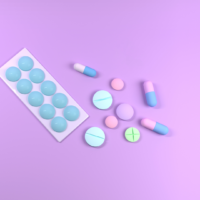Bubble Packing: A Comprehensive Guide to Its Benefits and Functionality for Your Loved One
 Welcome to our guide on bubble packing – your go-to resource for understanding this revolutionary approach to medication management. If you’re caring for a loved one or simply seeking ways to streamline their medication routine, bubble packing might just be the solution you’ve been searching for.
Welcome to our guide on bubble packing – your go-to resource for understanding this revolutionary approach to medication management. If you’re caring for a loved one or simply seeking ways to streamline their medication routine, bubble packing might just be the solution you’ve been searching for.
In essence, bubble packing, also referred to as unit dose packaging, simplifies the process of organizing medications by neatly arranging each dose in individual compartments, often sealed with protective bubbles. But its benefits extend far beyond mere organization. Bubble packing plays a crucial role in enhancing medication adherence, reducing errors, and ultimately improving the overall well-being of your loved one.
Understanding the potential benefits of bubble packing is key to ensuring your loved one receives their medications safely and effectively. That’s why we’ve put together this comprehensive guide, designed to walk you through everything you need to know about bubble packing and its functionality.
In the following sections, we’ll explore the various advantages of bubble packing for your loved one’s medication management. From enhanced organization to minimizing risks of missed doses, we’ll cover it all. Additionally, we’ll provide practical insights into how bubble packing works, its application in healthcare settings, real-life success stories, and much more.
So, whether you’re a caregiver looking to streamline medication administration or simply seeking ways to optimize your loved one’s healthcare routine, you’ve come to the right place. Let’s embark on this journey together and discover how bubble packing can make a meaningful difference in the lives of those we care about.
Understanding Bubble Packing: Definition, Evolution, and Types of Materials
In this section, we’ll dive into the fundamentals of bubble packing, tracing its evolution, and exploring the various types of materials used in the process.
-
Definition and Concept:
Bubble packing, also known as unit dose packaging, is a method of organizing medications into individual doses, typically sealed in compartments with protective bubbles. This approach simplifies medication management by ensuring each dose is easily accessible and clearly labeled, promoting adherence and minimizing the risk of errors.
-
Evolution and History:
The concept of bubble packing dates back several decades, with its roots in efforts to enhance medication safety and convenience. Over time, advancements in packaging technology have refined the bubble packing process, making it more efficient and user-friendly. Today, bubble packing is widely utilized in healthcare settings and has become a staple in medication management practices.
-
Types of Bubble Packing Materials:
There are various materials used in bubble packing, each offering unique benefits and features. Common types include:
- Plastic blister packs: Transparent plastic sheets with individual compartments for each dose, often sealed with aluminum foil.
- Strip packaging: Long strips of individual dose packs connected together, allowing for easy tearing and dispensing.
- Multi-dose pouches: Flexible pouches containing multiple doses, often used for medications taken at different times throughout the day.

 Understanding the different types of bubble packing materials allows caregivers and healthcare professionals to choose the most suitable option for their specific needs.
Understanding the different types of bubble packing materials allows caregivers and healthcare professionals to choose the most suitable option for their specific needs.
Benefits of Bubble Packing for Loved Ones: Enhancing Medication Management
Discover the remarkable advantages that bubble packing offers for your loved one’s medication routine. Let’s explore how this innovative approach can bring peace of mind and improved well-being.
-
Enhanced Organization and Convenience:
Bubble packing streamlines medication management by neatly organizing doses into individual compartments. This simplifies the process of medication administration, making it easier for caregivers and loved ones to keep track of doses and ensure timely consumption.
-
Improved Medication Adherence:
With medications clearly labeled and organized in bubble packs, loved ones are more likely to adhere to their prescribed regimen. The visual cues provided by bubble packing help individuals remember to take their medications as directed, reducing the risk of missed doses and improving overall health outcomes.
-
Reduction of Medication Errors:
Bubble packing minimizes the potential for medication errors by eliminating the need for manual sorting and measuring of doses. Each dose is pre-packaged and labeled with essential information, reducing the likelihood of confusion or administration errors.
-
Minimization of Environmental Exposure:
By sealing each dose in individual compartments, bubble packing helps protect medications from environmental factors such as moisture, light, and air. This helps maintain the efficacy and stability of the medications, ensuring they remain safe and potent for consumption.
Experience the peace of mind that comes with bubble packing – a simple yet effective solution for enhancing medication management and promoting well-being.
How Bubble Packing Works: Simplifying Medication Management
Curious about how bubble packing transforms medication organization? Let’s delve into the inner workings of this ingenious process.
-
Detailed Explanation of the Process:
Bubble packing involves carefully arranging individual doses of medication into sealed compartments within a sheet of plastic or foil. Each dose is precisely measured and labeled, ensuring accuracy and clarity. This systematic approach streamlines medication management, making it easier for caregivers and loved ones to keep track of doses.
-
Key Considerations for Effective Bubble Packing:
- Selection of Appropriate Packaging Materials:
Choosing the right packaging materials is crucial for bubble packing. Factors such as the type of medication, dosage frequency, and environmental conditions should be taken into account when selecting packaging materials to ensure optimal protection and stability.
- Proper Labeling and Identification:
Each bubble pack should be clearly labeled with essential information such as the medication name, dosage, instructions for use, and expiration date. Proper labeling ensures that caregivers and loved ones can easily identify and administer the correct dose at the right time.
- Handling and Storage Guidelines:
Proper handling and storage of bubble packs are essential to maintain the integrity and effectiveness of the medications. Bubble packs should be stored in a cool, dry place away from direct sunlight and moisture. Caregivers should also follow proper hygiene practices when handling bubble packs to prevent contamination.
By understanding the intricacies of bubble packing and adhering to key considerations, caregivers can ensure a smooth and efficient medication management process for their loved ones.
Application of Bubble Packing in Healthcare: From Pharmacies to Assisted Living
Discover how bubble packing revolutionizes medication management across various healthcare settings, ensuring convenience and accuracy for patients and caregivers alike.
-
Role of Bubble Packing in Pharmacies:
Pharmacies play a vital role in ensuring patients receive their medications safely and conveniently. Bubble packing streamlines this process by allowing pharmacists to pre-pack individual doses of medications, reducing waiting times and minimizing errors during dispensing. This ensures that patients receive the right medications in the correct dosage, enhancing overall medication adherence and patient satisfaction.
-
Integration into Home Healthcare Services:
For individuals receiving home healthcare services, managing medications can be challenging. Bubble packing simplifies this process by providing pre-packaged doses that are easy to administer and track. Home healthcare providers can utilize bubble packs to ensure patients receive their medications on time and in the correct dosage, promoting independence and well-being among patients while easing the workload of caregivers.
-
Impact on Geriatric Care and Assisted Living Facilities:
In geriatric care and assisted living facilities, medication management is often a complex and time-consuming task. Bubble packing alleviates this burden by organizing medications into easy-to-use packs that are tailored to each patient’s specific needs. This reduces the risk of medication errors and helps caregivers efficiently manage medications for multiple patients. Additionally, bubble packing enhances medication adherence among elderly individuals, leading to improved health outcomes and quality of life.
By incorporating bubble packing into healthcare settings, pharmacies, home healthcare services, and geriatric care facilities can streamline medication management processes, improve patient care, and enhance overall efficiency.

Case Studies and Success Stories: How Bubble Packing Changes Lives
Explore real-life examples and testimonials showcasing the transformative impact of bubble packing on medication management and patient care.
-
Real-Life Examples of Individuals Benefiting from Bubble Packing:
Meet Sarah, a busy working mom caring for her elderly father. With the help of bubble packing, Sarah efficiently organizes her father’s medications, ensuring he never misses a dose despite her hectic schedule. Similarly, John, a college student managing multiple medications for his chronic condition, finds relief in bubble packing, which simplifies his medication routine and boosts his adherence.
-
Testimonials from Caregivers and Healthcare Professionals:
“Bubble packing has been a game-changer for me and my patients,” says Nurse Kelly. “It saves time, reduces errors, and gives patients peace of mind knowing they’re taking the right medications.” Caregiver Lisa adds, “Since we started using bubble packing, my mom’s medication adherence has improved, and her health has noticeably improved.”
-
Insights into Improved Patient Outcomes:
Studies have shown that patients using bubble packing experience higher medication adherence rates and fewer missed doses compared to traditional medication management methods. Additionally, patients report feeling more confident and in control of their health with the help of bubble packing, leading to improved overall well-being and quality of life.
Discover firsthand how bubble packing transforms medication management and enhances patient outcomes in real-life scenarios.
Challenges and Limitations of Bubble Packing: Overcoming Hurdles for Better Medication Management
Let’s explore some of the challenges and limitations associated with bubble packing and how we can address them to ensure its effectiveness in medication management.
-
Potential Drawbacks of Bubble Packing:
While bubble packing offers numerous benefits, it’s essential to acknowledge its potential drawbacks. One common challenge is the limited capacity of bubble packs, which may not accommodate all medications, especially those with irregular shapes or sizes. Additionally, some individuals may find it difficult to open the sealed compartments, particularly those with dexterity issues.
-
Addressing Issues Related to Cost and Accessibility:
Cost can be a significant barrier to adopting bubble packing, especially for individuals with limited financial resources. Additionally, accessibility may be an issue for those living in remote areas or lacking access to pharmacies offering bubble packing services. However, exploring options such as insurance coverage or subsidies can help mitigate the financial burden, while expanding access to bubble packing services through online pharmacies or mail-order services can improve accessibility for individuals in underserved areas.
-
Strategies for Overcoming Common Challenges:
To overcome the challenges associated with bubble packing, several strategies can be implemented. These include:
- Working closely with healthcare providers to identify alternative packaging solutions for medications that may not fit into standard bubble packs.
- Providing clear instructions and demonstrations on how to open bubble packs effectively, particularly for individuals with limited dexterity.
- Exploring cost-saving measures such as bulk purchasing or generic alternatives to reduce the overall cost of bubble packing services.
- Collaborating with local pharmacies or healthcare facilities to expand access to bubble packing services in underserved communities.
By addressing these challenges and implementing strategic solutions, we can maximize the benefits of bubble packing and improve medication management for individuals across diverse settings.
Future Directions and Innovations in Bubble Packing: Shaping the Future of Medication Management
Explore the exciting advancements and potential trends that lie ahead in the world of bubble packing, revolutionizing how we manage medications.

-
Emerging Trends in Bubble Packing Technology:
As technology continues to evolve, so does bubble packing. We’re seeing the emergence of smart packaging solutions equipped with sensors and connectivity features, allowing for real-time monitoring of medication adherence and inventory levels. Additionally, advancements in automation and robotics are streamlining the bubble packing process, making it faster, more accurate, and cost-effective.
-
Potential Advancements in Customization and Personalization:
The future of bubble packing holds promise for greater customization and personalization. Imagine tailored bubble packs designed to meet the unique needs of each patient, with dosages adjusted based on individual factors such as age, weight, and medical history. Furthermore, the integration of patient data and electronic health records could enable healthcare providers to create personalized medication regimens optimized for each patient’s health goals and preferences.
-
Implications for the Future of Medication Management:
The continued innovation and adoption of bubble packing have profound implications for the future of medication management. With improved customization, personalization, and connectivity, patients will have greater control over their health and medication regimens. Healthcare providers will also benefit from enhanced visibility into patient adherence patterns, allowing for more targeted interventions and improved patient outcomes.
By embracing these future directions and innovations in bubble packing, we can look forward to a future where medication management is more efficient, effective, and patient-centered than ever before.
Practical Tips for Implementing Bubble Packing: Guidance for Caregivers and Healthcare Providers
Implementing bubble packing for medication management can be a game-changer, but it’s essential to do it right. Here are some practical tips to ensure a smooth and successful implementation.
-
Guidance for Caregivers and Family Members:
- Start by consulting with your loved one’s healthcare provider to determine if bubble packing is suitable for their medication regimen.
- Familiarize yourself with the bubble packing process and how to use the packs effectively. Your pharmacist or healthcare provider can provide instructions and demonstrations.
- Develop a system for storing and organizing bubble packs to ensure easy access and adherence to medication schedules.
- Regularly review and update the medication list with your loved one’s healthcare provider to ensure accuracy and consistency.
- Recommendations for Healthcare Providers:
- Educate patients and caregivers about the benefits of bubble packing and how it can improve medication adherence and safety.
- Offer training and support to patients and caregivers on how to use bubble packs effectively, including proper storage and handling.
- Collaborate with pharmacies and other healthcare providers to ensure seamless integration of bubble packing into patient care plans.
- Monitor patient adherence and outcomes regularly and adjust medication regimens as needed based on feedback and observations.
-
Resources for Further Information and Support:
- Encourage patients and caregivers to reach out to their pharmacist or healthcare provider for additional guidance and support.
- Provide educational materials and resources on bubble packing, including instructional videos and brochures, to help patients and caregivers feel confident in using this method.
- Refer patients and caregivers to support groups or online forums where they can connect with others who are using bubble packing and share tips and experiences.
By following these practical tips and leveraging available resources, caregivers and healthcare providers can successfully implement bubble packing to improve medication management and enhance patient care.
Conclusion: Embracing Bubble Packing for Better Medication Management
As we wrap up our exploration of bubble packing, let’s reflect on the key points and why it’s a valuable tool for improving medication management.
-
Recap of Key Points:
Throughout this guide, we’ve discussed how bubble packing simplifies medication organization, enhances adherence, and reduces errors. From its role in pharmacies to its impact on home healthcare services and geriatric care, bubble packing offers a range of benefits for patients and caregivers alike.
-
Encouragement for Exploring Bubble Packing:
If you’re caring for a loved one or seeking ways to streamline medication management, I encourage you to explore bubble packing as a solution. Its simplicity and effectiveness can make a significant difference in ensuring your loved one receives their medications safely and on time.
-
Final Thoughts on the Importance of Proactive Medication Management:
Proactive medication management is essential for maintaining health and well-being, especially for individuals with complex medication regimens. By embracing bubble packing and other innovative solutions, we can simplify the medication management process, promote adherence, and ultimately improve patient outcomes.
In closing, let’s continue to prioritize proactive medication management and leverage tools like bubble packing to enhance the quality of care for ourselves and our loved ones.
